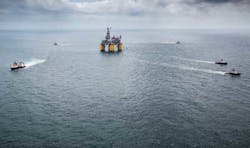Crowley Maritime Corp. reports that four of its ocean-class tugboats -Ocean Wind, Ocean Wave, Ocean Sky , and Ocean Sun - recently completed the successful delivery of the offshore oil production and drilling platform Olympus to the US Gulf of Mexico. The project was significant because it provided the first opportunity for all four of the company's new high-bollard-pull, ocean-class tugboats to work together on a single job. The rig, owned by Shell, is considered the largest tension-leg platform ever to be developed for the US Gulf of Mexico.
The Crowley ocean-class tugs worked together in both nearshore and offshore waters to relocate the 120,000-ton, 406-ft tall TLP from Ingleside, Texas, 425 mi to its deepwater location in the GoM. During the nearshore phase, theOcean Wind and Ocean Wave provided assistance in pushing the Olympus away from the Kiewit facility dock in Ingleside, through the Port of Aransas, Texas, and out to deeper waters. During this initial phase, the Ocean Sky was also available and equipped to provide push assistance, if needed.
Once safely outside of the port,Ocean Wave, Ocean Wind, and Ocean Sun towed the vessel to its final location in more than 3,000 ft of water. During this offshore phase, Ocean Sky took on the role of escort tug, which helped to ensure the towing vessels' and platform's safety. Providing additional support was the Crowley-contracted, offshore tugboat Harvey War Horse II.
In the final stage, called the positioning phase, theOcean Wind, Ocean Wave, and Ocean Sun vessels helped position the platform in its final location and remained on site in a star pattern to provide support as the platform was attached to tendons and made storm safe. The Ocean Sky remained on site as a stand-by vessel and to provide additional security.
"This successful project is a testament to the capability, station-keeping and power of these vessels," said Crowley's John Ara, vice president, solutions. "The design of the ocean class has allowed us to participate in the full scope of marine transportation, including nearshore, offshore, and positioning work. From the initial push-off to securing it as storm-safe, these tugs were critical assets in the relocation of theOlympus platform."
Now that theOlympus has been delivered safely, the Ocean Wind, Ocean Wave, and Ocean Sun are already at work on another project, this time transporting the Lucius spar platform for Anadarko. The 80,000 b/d of oil capacity spar is now under tow with Crowley for more than 300 mi to its final location in the deepwaters of the US GoM. Once delivered, it will be installed in about 7,100 ft of water to produce oil and natural gas from beneath the seafloor.
Western GoM lease sale high bids total $102 million-plus
Western Gulf of Mexico Lease Sale 233, which took place in late August, drew more than $102 million in high bids for 53 tracts on the OCS. Bids covered 301,006 acres of the nearly 21 million on offer.
The highest bid on a single tract was $30,583,560 by ConocoPhillips for Alaminos Canyon block 475. ConocoPhilips also submitted the highest total amount in bonus bids, $50,323,180 on 29 tracts.
Chevron submitted the next two highest bids: $19,102,687 and $13,111,191 for East Breaks blocks 499 and 500, respectively. Chevron submitted the second-highest total amount at $32,323,180 with just three bids, while Maersk Oil placed third at a total of $6,823,281 in seven bids.
This sale offered all unleased and non-protected areas in the Western Gulf of Mexico planning area, including 3,864 tracts from nine to more than 250 mi off the coast, in depths ranging from 16 to more than 10,975 ft. BOEM estimates the lease sale could result in the production of 116 to 200 MMbbl of oil and 538 to 938 bcf of natural gas.
BP begins appraisal drilling at Tiber prospect
BP has begun appraisal drilling on its Tiber oil prospect in the Gulf of Mexico.
According to a Reuters report, BP confirmed that drilling began on Aug. 3. ConocoPhillips CEO Ryan Lance disclosed the status to analysts during a webcast presentation at the Barclays Energy-Power Conference in New York. ConocoPhillips is a minority partner in Tiber.
In 2009, BP touted what it called a "giant" oil discovery in the Tiber field next to its Kaskida field that could hold up to 3 Bbbl of oil. Both fields are in the Lower Tertiary trend, the Gulf's deepest, most challenging, and most promising deposit that is estimated to hold up to 15 Bbbl of oil.
BP had planned in 2010 to drill appraisal wells in the Tiber field to help gauge how much oil was there. The company's Macondo rupture and spill prompted the shutdown that delayed those plans.
That drilling plan resumed last month with the start of the new well in Tiber. BP had already begun exploratory drilling at another prospect near Tiber, called Gila, and that work is continuing.
Prospects in Mexico for IOCs show positive signs
Deepwater Gulf of Mexico exploration and production may prove to be the lever that opens Mexico to international oil company (IOC) participation.
Mexico currently is seeing a drop in production that could be alleviated by success in the GoM, but the state-owned Petróleos Mexicanos does not have the technical experience to operate in such deepwater, said George Baker, managing principal, Baker & Associates, speaking at BNamericas' LatAm Oil & Gas Summit.
That, coupled with the current push by Mexico's President Enrique Peña Nieto to change the national rules to permit companies outside of Mexico to enter profit-sharing agreements, could succeed in changing the operating agreements sufficiently to permit IOCs to enter.
That does not necessarily change the prevailing "national narrative" about ownership of the reserves, however, Baker pointed out. Whether the reforms are adopted and, if so, in what form, remains to be seen.





